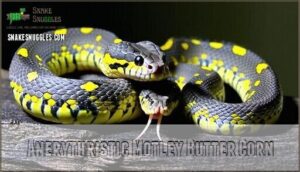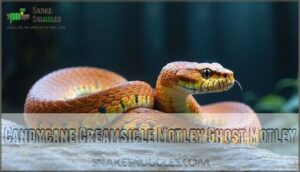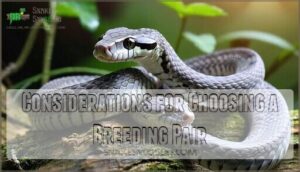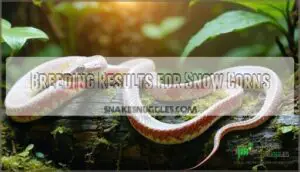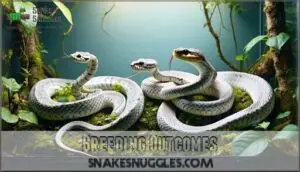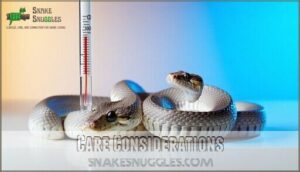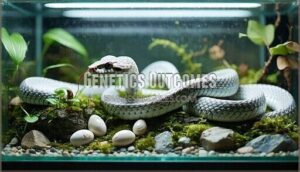This site is supported by our readers. We may earn a commission, at no cost to you, if you purchase through links.
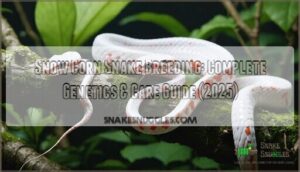
Snow corns express both anerythrism and amelanism—two recessive mutations that create their stunning white appearance with red eyes.
When you’re planning breeding pairs, you’ll need compatible genetics to produce viable offspring.
The breeding season runs from late winter through early spring, with females laying 10-30 eggs after a 55-60 day incubation period.
Success depends on proper brumation, temperature cycling, and understanding morph compatibility.
Your breeding outcomes will vary based on the specific genetic combinations you choose, but the possibilities for creating unique morphs make it worth mastering these fundamentals.
Table Of Contents
- Key Takeaways
- Snow Corn Snake Genetics
- Breeding Options for Snow Corns
- Pairing Suggestions for Snow Corns
- Considerations for Choosing a Breeding Pair
- Breeding Results for Snow Corns
- Mixing Traits for Desired Outcomes
- Breeding Process
- Breeding Outcomes
- Care Considerations
- Genetics Outcomes
- Frequently Asked Questions (FAQs)
- Are corn snakes hard to breed?
- How long does it take to breed corn snakes?
- What is the breeding behavior of a corn snake?
- What time of year do corn snakes lay eggs?
- Are corn snakes easy to breed?
- How long after pairing do corn snakes lay eggs?
- What is the mating ritual of corn snakes?
- How long does the breeding process take?
- What are the ideal housing requirements?
- Are there any health concerns specific to snows?
- Conclusion
Key Takeaways
- You’ll need both anerythrism and amelanism genes in homozygous form to produce snow corn snakes, as these recessive mutations work together to create the characteristic pale coloration with red eyes.
- Your breeding success depends on proper brumation and temperature cycling, which synchronizes reproductive cycles and can increase clutch sizes from 10-30 eggs after a 55-60 day incubation period.
- You can predict breeding outcomes accurately – pairing two snows produces 100% snow offspring, while crossing a snow with a normal corn creates 100% het snow carriers that don’t show the visual morph.
- You’ll expand your breeding program by mixing snow genetics with other morphs like motley, caramel, or lavender to create compound mutations that produce unique color patterns and increased genetic diversity.
Snow Corn Snake Genetics
Understanding snow corn snake genetics requires grasping how two recessive mutations—anerythrism type A and amelanism—combine to produce this distinctive morph.
You’ll need both genetic components present in homozygous form to achieve the characteristic pale coloration that defines snow corn snakes.
Anerythrism and Amelanism
Two fundamental genetic traits create snow corn snakes’ striking appearance.
Anerythrism blocks red pigment production, while amelanism prevents melanin formation – basically removing black coloration.
These recessive mutations work together like a genetic recipe.
- Anerythrism: Eliminates red/orange hues, creating grayscale patterns
- Amelanism: Removes dark pigments, producing the characteristic pale, translucent appearance with red eyes
Understanding these albino genetics guarantees successful morph expression.
Recessive Mutations
Understanding recessive mutations helps you crack the genetic code behind snow corn snakes.
Both parents must carry identical recessive genes for trait expression to occur in offspring.
Anerythrism and amelanism work together through specific inheritance patterns, requiring genetic compatibility between breeding pairs.
Consider these breeding outcomes that’ll spark your excitement:
- Snow x normal produces 100% normal offspring carrying hidden genetics
- Snow x amel creates 100% amelanistic babies
- Snow x normal het anery yields 50% anerythristic, 50% normal outcomes
- Genetic testing reveals gene interactions before pairing decisions
Dominant Mutations
Unlike recessive mutations that hide in genetic shadows, dominant alleles in corn snakes take center stage immediately.
These powerful genes create striking visual results in first-generation crosses.
Three key dominant mutations revolutionize breeding corn snakes:
- Ultra Morphs – Codominant genes producing brilliant ultramel expressions
- Tessera Genetics – Create distinctive geometric patterns instantly
- Buf Mutations and Toffee Traits – Add rich coloration through single-gene inheritance
Understanding the role of corn snake genetics is essential for successful breeding programs.
Breeding Options for Snow Corns
You’ll discover several strategic breeding combinations that enhance your snow corn snake’s genetic diversity and visual characteristics.
Pairing snow corns with motley, caramel, or lavender morphs creates compound mutations that produce offspring with striking color patterns and increased market value, which can be a key factor in their visual characteristics.
Anerythristic Motley Butter Corn
Anerythristic motley butter corns showcase stunning Color Patterns that’ll make your heart skip a beat.
These corn snake morphs combine the anerythristic gene’s gray tones with butter’s creamy yellows and motley’s distinctive patterns.
When you’re planning snow corn snake breeding, pairing with anerythristic type A corn snake creates incredible Morph Genetics diversity.
Genetic Testing confirms these recessive traits produce visually spectacular offspring every time.
Candycane Creamsicle Motley Ghost Motley
Looking to create something truly spectacular? Pairing your snow with a candycane creamsicle motley ghost motley delivers jaw-dropping results.
The creamsicle gene brings brilliant orange hues, while ghost and motley contribute complex morph patterns. This corn snake morphs combination showcases advanced color genetics and breeding tips.
It’s demanding work requiring genetic testing, but the extraordinary offspring justify every effort. Understanding the role of lavender corn genetics is vital for successful breeding outcomes.
Pairing Suggestions for Snow Corns
Smart breeders know that successful snow corn snake breeding hinges on selecting compatible partners that’ll produce stunning offspring.
Strategic partnerships unlock breathtaking genetic combinations that transform ordinary breeding into extraordinary morphs.
When you’re planning your next breeding project, these strategic pairings offer excellent genetic diversity while maintaining the snow’s signature appeal.
Consider these proven morph pairing combinations for desired results:
- Snow het caramel – Creates warm butterscotch contrasts against the snow’s pale foundation
- Snow het lavender – Produces soft pastel variations with enhanced color saturation
- Snow het motley – Generates intricate pattern disruptions while preserving clean morph expression
- Snow het ghost – Develops ethereal appearances with subtle color variations
Each pairing strategy maximizes genetic compatibility while expanding your breeding program’s potential.
These breeding tips guarantee you’ll achieve desired color variations without compromising snake compatibility or morph stability.
Considerations for Choosing a Breeding Pair
You’ll need to evaluate genetic compatibility between potential breeding pairs by examining their heterozygous and homozygous gene combinations for both amelanistic and anerythristic type A mutations.
Consider the morph expression potential and desired offspring traits when selecting pairs, as these factors directly influence whether you’ll produce visual snow morphs or heterozygous carriers in your clutch.
Genetic Compatibility Factors
Genetic compatibility forms the foundation of successful snow corn breeding. You’ll need genetic testing to identify carriers and predict breeding outcomes. Understanding trait inheritance patterns helps you pair snakes strategically for desired gene expression.
| Parent 1 | Parent 2 | Offspring Probability |
|---|---|---|
| Snow (rrbb) | Wild-type (RRBB) | 100% het both traits |
| Snow (rrbb) | Amelanistic (rrBB) | 100% amel het anery |
| Snow (rrbb) | Anerythristic (RRbb) | 100% anery het amel |
| Snow (rrbb) | Snow (rrbb) | 100% snow |
| Het snow (RrBb) | Het snow (RrBb) | 1/16 snow probability |
Recessive mutations require both parents carrying identical genes for visual expression. Dominant mutations appear with single-gene inheritance, affecting mutation rates in offspring generations.
Morph Expression Potential
When evaluating breeding pairs, you’ll need to assess how genetic traits will visually express in offspring.
Different corn snake morphs showcase varying probabilities for desirable outcomes.
Consider these morph expression factors:
- Recessive mutations require both parents carrying the gene for visual expression
- Dominant mutations express with just one parent contributing the trait
- Color variations depend on trait inheritance patterns and genetic compatibility
- Morph patterns emerge through complex genetic mutations interactions
Desired Offspring Traits
When selecting breeding pairs, your morph selection directly impacts trait inheritance and genetic diversity.
Consider which color patterns align with your breeding goals – whether you’re targeting specific corn snake morphs or exploring new combinations.
Understanding genetic compatibility and morph expression helps predict recessive mutations in offspring.
Breeders must recognize the importance of lavender corn genetics to acknowledge the potential impact on their breeding program.
| Pairing Goal | Expected Trait |
|---|---|
| Enhanced Pink Coloration | Selective breeding emphasizes pink hues |
| Pattern Complexity | Motley or stripe combinations |
| Multi-trait Expression | Triple or quad genetic traits |
Breeding Results for Snow Corns
After carefully selecting your breeding pair, you’re probably wondering what offspring you’ll actually get. Snow genetics follow predictable patterns that make corn snake breeding exciting yet manageable.
Breeding two snow corn snakes produces 100% snow offspring – the most straightforward pairing. Pairing a snow with a het snow yields 50% visual snows and 50% het snows. Crossing a snow with normal corn snakes creates 100% het snow offspring that carry hidden recessive genes.
Here’s what makes snow corn snake morph breeding truly rewarding:
- Watching tiny hatchlings emerge with those distinctive pink and white color variations
- Discovering which offspring traits each clutch will express from their genetic lottery
- Building your breeding program with predictable morph patterns that compound over generations
Understanding these breeding tips helps you plan multi-generational projects with confidence.
Mixing Traits for Desired Outcomes
Success in genetic mixing comes from understanding how traits combine in corn snake morphs. You’ll achieve stunning results by strategically pairing breeding pairs with complementary mutations.
Pattern development occurs when you combine tessera, motley, or stripe genes with snow genetics, creating unique visual expressions.
Consider these trait blending approaches:
- Combine snow with caramel or lavender for enhanced color enhancement possibilities
- Pair anerythristic motley with amelanistic butter for complex pattern variations
- Mix charcoal genetics with snow for striking contrast combinations.
Research genetic compatibility before selecting pairs. Morph expression varies substantially based on parental genetics. Careful morph creation requires analyzing pedigrees and understanding genetic outcomes to achieve your desired visual results, which can lead to unique visual expressions and complex pattern variations with the right combination of genes, such as snow genetics.
Breeding Process
Through proper snake breeding techniques, you’ll transform your genetic knowledge into living results.
The breeding corn snakes process requires precise timing and environmental control to maximize success rates.
Your breeding strategies should focus on these essential steps:
- Genetic Testing – Verify both parents carry desired recessive mutations before pairing
- Morph Selection – Choose breeding pairs based on genetic compatibility and offspring prediction goals
- Pre-breeding Conditioning – Separate males and females for 30-60 days to build reproductive drive
- Environmental Setup – Provide nest boxes with appropriate substrate once you introduce pairs
- Incubation Management – Maintain steady temperatures (78-82°F) and humidity levels throughout development
Pairing outcomes depend heavily on your preparation.
Monitor closely for breeding behavior, then focus on creating ideal conditions for egg development and hatching success.
Understanding breeding age requirements is vital for a successful breeding program.
Breeding Outcomes
Once you’ve completed the breeding process, understanding your genetic results becomes the moment of truth. Your breeding outcomes directly reflect the parental genetics you’ve paired together.
Snow corn snake breeding produces predictable patterns when you understand the inheritance mechanics. Each pairing combination yields specific offspring traits based on the genetic makeup of both parents.
Here’s what you can expect from common breeding scenarios:
- Snow x Snow pairing: Guarantees 100% snow offspring with consistent morph expression
- Snow x Amelanistic cross: Produces 100% amelanistic het anerythristic babies
- Snow x Normal pairing: Results in normal het anerythristic/amelanistic offspring
- Complex multi-trait crosses: Create variable outcomes requiring F2 generation analysis
Breeding success depends on tracking each parent’s genetic background carefully. Hybridization with other morphs can produce stunning combinations, but you’ll need patience. Some desired morph patterns won’t appear until the second generation, making genetic inheritance documentation essential for achieving your target offspring traits.
Care Considerations
You’ll need to maintain ideal environmental conditions and monitor genetic compatibility when breeding snow corn snakes (Pantherophis guttatus).
Proper brumation protocols and understanding recessive mutation inheritance patterns directly impact your breeding success rates and offspring viability.
Recessive Mutation Considerations
Recessive genes in snow corn breeding require both parents carrying specific mutations for trait expression.
Understanding inheritance patterns helps predict outcomes when combining anerythrism and amelanism.
Genetic testing reveals hidden carriers, while breeding strategies must account for recessive nature requiring two gene copies for visual expression.
This understanding of genetic principles is essential for mastering Corn Snake Genetics.
| Mutation Type | Inheritance Pattern | Expression Requirement |
|---|---|---|
| Anerythrism | Recessive | Both parents carry gene |
| Amelanism | Recessive | Homozygous pairing needed |
| Snow Morph | Double Recessive | Anery + Amel combination |
| Normal Het | Carrier | One copy, no expression |
| Visual Morph | Homozygous | Two matching gene copies |
Pairing and Morph Analysis
Morph Genetics analysis becomes your roadmap when Snake Pairing snow corns. You’ll want to map out het combinations and calculate Genetic Outcomes before breeding corn snakes.
Study each potential pair’s genetic compatibility and Morph Expression patterns. Smart Breeding Strategies involve examining your breeding stock’s genetics, predicting offspring traits, and selecting pairs that’ll produce your target snow corn snake variations with consistent results.
Understanding Corn Snake Morphs is essential for successful breeding programs, as it involves studying snake morph varieties to create unique offspring.
Brumation and Breeding Success
Two months of strategic cold induction transforms your snake breeding process completely.
Temperature control during brumation synchronizes breeding cycles, boosting fertility rates substantially.
While corn snake breeding succeeds without cooling, this natural approach optimizes reproductive success.
Brumation benefits for breeding corn snakes:
- Enhanced sperm production in males during cooling periods
- Improved ovulation timing when females emerge from rest
- Larger clutch sizes with better snake incubation rates
- Synchronized reproductive cycles between breeding pairs
- Reduced snake health complications during mating season
Genetic testing confirms proper pairing outcomes regardless of cooling methods chosen.
Successful breeders often rely on proper snake breeding kits to guarantee the best results.
Genetics Outcomes
Understanding breeding predictions becomes your roadmap to success when working with snow corn snake genetics.
Genetic testing reveals how trait expression unfolds across generations, while gene interaction determines which morphs appear in your clutches.
Here’s what you can expect from common pairings:
| Pairing | Expected Offspring |
|---|---|
| Snow x Snow | 100% Snow |
| Snow x Amelanistic | 100% Amelanistic het Anerythrism |
| Snow x Normal het Amelanistic | 50% Snow, 50% Amelanistic het Anerythrism |
Corn snake genetics follow predictable patterns when you grasp the fundamentals.
Morph inheritance depends on genetic compatibility between parents, with anerythrism playing a key role in snow production.
These genetic outcomes help you plan breeding programs that consistently produce desired morphs while maintaining healthy bloodlines.
Frequently Asked Questions (FAQs)
Are corn snakes hard to breed?
Like planting seeds in fertile soil, corn snake breeding isn’t rocket science.
You’ll find these gentle constrictors surprisingly cooperative when conditions align—proper temperatures, cycling, and genetics create success.
Most beginners achieve clutches with basic knowledge and patience.
How long does it take to breed corn snakes?
Corn snake breeding cycles typically span 12-18 months from initial pairing to hatching.
You’ll need 3-4 months for brumation, 2-3 months for breeding/gestation, plus 60-65 days for egg incubation before babies emerge.
What is the breeding behavior of a corn snake?
Breeding behavior involves courtship rituals where males track females through pheromone trails.
You’ll observe chin-rubbing, body alignment, and gentle coiling before mating occurs.
Females become receptive during spring cycles, displaying specific behavioral cues.
What time of year do corn snakes lay eggs?
You’ll find corn snakes typically lay their eggs during late spring to early summer, usually between May and July.
This timing coincides with warmer temperatures that provide ideal incubation conditions for successful hatching, which is a result of the ideal incubation.
Are corn snakes easy to breed?
Picture assembling a jigsaw puzzle—corn snakes breed with similar predictability once you’ve mastered the pieces.
You’ll find they’re remarkably straightforward to breed, requiring basic temperature cycling, proper nutrition, and patience for their natural reproductive instincts.
How long after pairing do corn snakes lay eggs?
After successful mating, you’ll typically wait 30-45 days before your female corn snake lays her clutch.
She’ll become noticeably thicker around the middle, and you’ll need to provide a suitable nesting box with moist substrate.
What is the mating ritual of corn snakes?
You’ll observe male corn snakes performing an elaborate courtship dance, vibrating their tails, rubbing against females, and aligning their bodies.
This ritualistic behavior stimulates ovulation and guarantees successful mating through gentle persistence and chemical communication.
How long does the breeding process take?
Time flies when you’re breeding corn snakes.
You’ll wait about 60-75 days from mating to egg-laying, then another 60-65 days for incubation.
That’s roughly four months total before you’re holding those precious hatchlings.
What are the ideal housing requirements?
You’ll need a minimum 20-gallon tank, though 30-40 gallons works better for adults.
Maintain 75-85°F daytime temperatures with a heat pad covering one-third of the floor, plus hiding spots and aspen substrate.
Are there any health concerns specific to snows?
Snow corn snakes don’t face unique health issues beyond typical corn snake concerns.
You’ll watch for respiratory infections, mites, and feeding problems.
Their genetic makeup doesn’t create additional vulnerabilities compared to normal morphs, which means they don’t have unique health issues.
Conclusion
Breeding snow corn snakes isn’t just about pairing pretty snakes—it’s a genetic puzzle where recessive mutations like anerythrism and amelanism take center stage.
By mastering morph compatibility and brumation techniques, you’ll release the potential for unique offspring.
Remember, each pairing is a calculated step toward creating stunning variations, and with proper care, temperature cycling, and a bit of patience, snow corn snake breeding becomes both a science and an art worth exploring.
Ready to start your next clutch?

